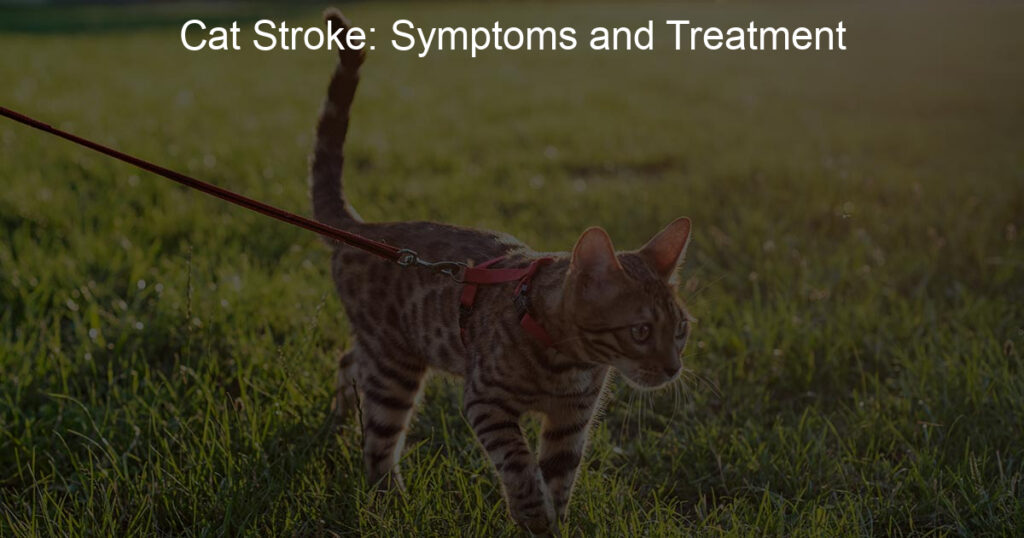Are you a cat lover? Worried your furry friend might be having a stroke? Many pet owners don’t know that cats can also suffer from strokes, just like people. A cat stroke is an underdiagnosed and underrecognized condition, but it’s important to identify the signs of this medical emergency so that you can get your kitty the help they need.
In this blog post, we’ll discuss what causes cat strokes, their symptoms, and how they’re treated. So if you’ve been seeing any concerning behavior in your feline family member lately – read on!
Can a cat recover from a stroke?
Strokes can be devastating for any creature, and cats are no exception. Fortunately, if the stroke is not severe, cats have a good prognosis for recovery—although full recovery may not be possible. With supportive care from a veterinarian, such as anti-inflammatory medications, oxygen therapy, and dietary adjustments, cats can often renew their strength and gradually restore movement on the affected side of their body.
It’s important to provide a safe environment so your cat won’t have to struggle to maneuver around with its limited mobility. A collaborative effort between you and your vet can make sure that your feline companion is afforded the best chance of recovering from their stroke.
How does a cat act after a stroke?
Strokes can be just as debilitating for cats as they are for people, causing them to experience difficulty with motor skills and balance. When it comes to cats that have had strokes, their behavior can change drastically. A cat may become more tired than usual and struggle to complete basic activities such as climbing or jumping like it used to.
Additionally, they may begin to show signs of confusion, such as walking in circles or being confused by familiar places, objects, and routines. If your pet has had a stroke, it’s important to remain patient and provide them with plenty of love as they recuperate – this will help them eventually adjust back to their regular lifestyle.
How do you know if a cat has had a stroke?
Knowing if a cat has had a stroke can be tricky since cats often hide their symptoms. Paying attention to the cat’s behavior is key. A cat may appear disoriented, shake violently, or appear panting or breathing heavily. It’s also common for cats to experience loss of balance, problems with coordination, and/or difficulty moving their legs.
If you notice any of these symptoms in your pet, it’s important to take them to a vet right away to make sure they haven’t had a stroke and that they get the proper treatment if they have experienced one. It is difficult watching your furry friend suffer so being aware of signs of a possible stroke can help get them the care they need quickly.
How can I treat my cat’s paralysis at home?
Taking care of a paralyzed cat can be overwhelming, but the good news is you don’t have to do it alone. With the right knowledge and supplies, treating your pet at home can give them much-needed comfort and be an empowering part of their recovery. It’s important to mention that managing paralysis in cats should be done with guidance from a vet, as proper management depends on an accurate diagnosis.
Also, there are many ways to ease their discomfort and increase your pet’s mobility so look into what might work best for your specific situation. Thankfully, common treatments like dietary changes with proper nutrition, regular physical therapy or massage therapy, the use of a cart or sling if necessary, and keeping their environment clean and cozy can all be accomplished at home!
How can I save my cat from a stroke?
Knowing the signs of a stroke in cats can be life-saving. If your cat is exhibiting any unusual behavior such as loss of balance, paralysis in certain parts of the body, a head tilt, weak muscle control, or confusion, these could be signs that your cat is having a stroke so take them to the veterinarian immediately. However, prevention is key, and there are steps that you can take to reduce your cat’s risk.
It is important to ensure their diet is balanced and they get enough exercise as well as keep up with regular health checkups with their vet. Keeping an eye on their weight and taking measures to avoid obesity can also help since overweight cats are more likely to suffer from strokes. Reducing stress levels is also recommended since it can raise the risk of stroke along with other serious health issues.
Summary
To conclude, cat strokes can be a devastating experience for you and your cat. It is important to remember to remain calm if there is ever a situation where you suspect your cat may have had a stroke. Knowing the symptoms associated with cat strokes can help you recognize them early on and seek treatment quickly.
Thankfully, cats make amazing patients and have a great chance of making a full recovery with the right treatment. If you ever need more tips or support, never hesitate to reach out to your vet or trusted online pet community forums — there are plenty of experienced pet owners ready to lend their support and advice.
Ultimately, it is reassuring that strokes in cats can be successfully treated as long as they’re identified early enough — and often even completely reversed!












